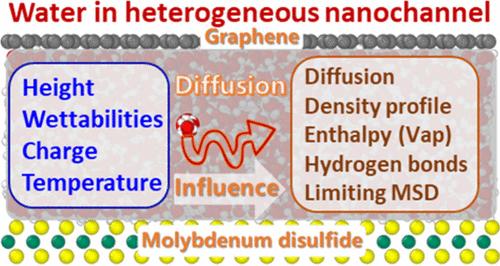水在非均质纳米通道中的扩散机制
IF 3.9
2区 化学
Q2 CHEMISTRY, MULTIDISCIPLINARY
引用次数: 0
摘要
异质约束系统因其在不同领域的广泛应用而日益受到关注。然而,目前还缺乏通过分子模拟来深入了解水在异质纳米通道中的扩散机制和物理性质。本文利用高精度 TIP4P-BGWT 水分子封闭在二硫化钼(MoS2)和石墨烯壁中,研究了通道高度、壁的润湿性、MoS2 的电荷和温度等变量对扩散机制和物理性质的影响。模拟结果表明,扩散机制受通道高度和温度的影响较大,但受壁的润湿性影响较小。可以观察到通道高度和温度对物理性质的影响,但墙壁润湿性的影响较小。所考虑的变量(不包括 MoS2 的电荷)对密度分布有显著影响,而通道高度的极限均方位移则完全取决于有效扩散距离。值得注意的是,与同质结构相比,由于不同的固液相互作用,异质纳米通道的密度分布存在显著差异。本研究为纳米膜、纳米传感器、微流控芯片等纳米器件的设计奠定了坚实的基础。本文章由计算机程序翻译,如有差异,请以英文原文为准。

Untangling the Diffusion Mechanism of Water in a Heterogeneous Nanochannel
Heterogeneous confinement systems attract increasing attention owing to their widespread applications in diverse areas. However, it is still lacking an in-depth understanding of the diffusion mechanism and physical properties of water in the heterogeneous nanochannel through molecular simulations. Here, high-precision TIP4P-BGWT water molecules confined in molybdenum disulfide (MoS2) and graphene walls are utilized to investigate the influences of variables, i.e., channel height, wettability of walls, charge of MoS2, and temperature, on the diffusion mechanism and physical properties. The simulation results indicate that the diffusion mechanism is significantly affected by the channel height and temperature but weakly influenced by the wettability of walls. Observable impacts on the physical properties can be observed with the channel height and temperature, but slight impacts are observed with the wettability of walls. Considered variables, excluding charge of MoS2, remarkably influence density distribution, while limiting mean square displacement at the channel height depends solely upon the effective diffusion distance. It is worth noting that, compared to the homostructure, significant discrepancy in the density distribution can be obtained from the heterogeneous nanochannel due to different solid–liquid interactions. The present study offers a solid foundation for the design of nanodevices, such as nanomembrane, nanosensor, microfluidic chip, etc.
求助全文
通过发布文献求助,成功后即可免费获取论文全文。
去求助
来源期刊

Langmuir
化学-材料科学:综合
CiteScore
6.50
自引率
10.30%
发文量
1464
审稿时长
2.1 months
期刊介绍:
Langmuir is an interdisciplinary journal publishing articles in the following subject categories:
Colloids: surfactants and self-assembly, dispersions, emulsions, foams
Interfaces: adsorption, reactions, films, forces
Biological Interfaces: biocolloids, biomolecular and biomimetic materials
Materials: nano- and mesostructured materials, polymers, gels, liquid crystals
Electrochemistry: interfacial charge transfer, charge transport, electrocatalysis, electrokinetic phenomena, bioelectrochemistry
Devices and Applications: sensors, fluidics, patterning, catalysis, photonic crystals
However, when high-impact, original work is submitted that does not fit within the above categories, decisions to accept or decline such papers will be based on one criteria: What Would Irving Do?
Langmuir ranks #2 in citations out of 136 journals in the category of Physical Chemistry with 113,157 total citations. The journal received an Impact Factor of 4.384*.
This journal is also indexed in the categories of Materials Science (ranked #1) and Multidisciplinary Chemistry (ranked #5).
 求助内容:
求助内容: 应助结果提醒方式:
应助结果提醒方式:


